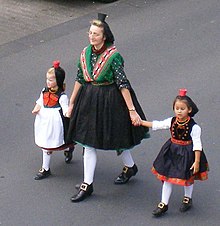Schwalm (culture)
The Schwalm is a cultural area in northern Hesse .
It was named after the river Schwalm Schwalm , at the middle reaches it is located. The residents of the Schwalm are called Schwalmers. The cultural area is characterized by the Schwalm traditional costume , the Schwalm dialect and specific customs, especially festive customs.
Costume, dialect and customs
For example, a large number of skirts worn one on top of the other as well as a characteristic Betzel, which is often incorrectly referred to as the model of Little Red Riding Hood in the fairy tale of the Brothers Grimm , belong to the Schwalm costume of women . In fact, the fairy tale does not have its origin in the Schwalm, but the Brothers Grimm collected many oral traditions here . The old age costume was still worn by a few women in everyday life in 2013. The male costume has long since disappeared from everyday life. The costume is used on festive days, e.g. B. the Ziegenhainer Salad Fair is shown.
The Schwälmer Platt is a living, rural colloquial language that has also found expression in literature. In particular, the volume of poetry Kreizschwerneng, FUN muss seng by Johann Heinrich Kranz and Johann Heinrich Schwalm , written in dialect, had a significant impact on the Schwalm's cultural identity in the 20th century.
The customs belonging to the traditional cultural area Schwalm are z. B. shown by Schrödter. These include B. the Schwälmer song (Loshäuser Kirmeslied, written by Erhard Georg von Lüder), which contains the following line of text about typical, traditional feasts (soup, meat, millet porridge, beer):
Wake-up stop, Fleesch, o Härschebree, eat merry, o drink beer derbee
Other customs are traditional dances that are still practiced today, such as the Schwälmer, other fun fair, wedding and spring customs and much more.
Geographical limitation
Schrödter counts the following localities to the closer Schwalm: Wasenberg , Willingshausen , Merzhausen , Leimbach , Ransbach , Gungelshausen , Loshausen , Zella , Salmshausen , Röllshausen , Schrecksbach , Holzburg , Rückershausen , Riebelsdorf , Steina , Niederlimitebach , Oberbegrenzebach and Ascherode .
The following villages are also part of the Schwalm (Hecken-Schwälmer): Hattendorf , Immichenhain , Ottrau , Görzhain , Kleinropperhausen , Nausis , Schorbach , Asterode , Christerode , Hauptschwenda , Seigertshausen , Leimsfeld , Allendorf an der Landsburg , Frankenhain , Florshain and Wiera . Schwalm also includes: Berfa , Dittershausen , Mengsberg , Michelsberg , Rörshain , Rommershausen , Schönborn and Weißenborn . In the further Schwalm the influence of the Schwalm plateau and the Schwalm costume was less.
The towns of Ziegenhain , Treysa and Neukirchen , which are close to these villages, were important for the residents of the Schwalm for buying and selling goods and for administrative acts, but were not directly part of the Schwalm cultural area. This was rural. As a rule, the inhabitants of the cities did not wear traditional Schwalm costumes.
Other important places related to the Schwalm cultural area are the Schönberg chapel and the Wipperstein natural monument . The Schwalm cultural area was part of the old district of Ziegenhain and is now mainly in the Schwalm-Eder district .
Willingshausen painters colony, museums and associations
The Schwalm became known nationwide as a cultural area, in particular through the Willingshausen painters' colony . The painters found their motives in the people, their activities and customs. An example of this is the painting Schwalm Dance from 1897/98 by Carl Bantzer , which is in the Marburg University Museum for Art and Cultural History.
The Schwalm cultural area is extensively presented in the Schwalm Museum, supported by the Schwalm Heimatbund eV, and in the Schwalm Village Museum in Holzburg . Customs that are no longer anchored in everyday life are partly carried on by associations.
literature
- E. Mathias Schumacher: Small trip to the Schwalm . Verlag Ludwig Simon, 44 pages, format about A4, with numerous illustrations (black and white), Volume 27 of the book series Die Deutsche Bücher , Berlin 1935
- Heinz Rübeling, Heinz Metz, Dirk Ordemann: The Schwalm costume . Verlag Dirk Ordemann, Ziegenhain 1988, ISBN 3-9802008-0-9 .
- August Gandert, Brunhilde Miehe: Handicrafts and folk art in the Schwalm . Schwalm Heimatbund, Ziegenhain 1983.
- E. Schade, K. Schade, B. Selentschik, K. Selentschik: Life in the Schwalm - Documentation with historical photographs from Röllshausen and Salmshausen . Self-published, Röllshausen 1987.
- Olaf Plotz, Traugott Heil: Schwalm and Knüll - A landscape in the middle of Germany . Edition Wallgraben, Schwalmstadt 1992, ISBN 3-9803231-0-2 .
- The Schwalm . With 12 illustrations based on original photos by Johanna Eilert (Märzhausen, Niedergränzebach, Treysa, Willingshausen, Riebelsdorf). In: Vom Fels zum Meer 22nd vol., Vol. 2, 1903, pp. 1761–1767.
- The Schwalm - people in pictures . 107 historical photographs by Hans Retzlaff, compiled, explained and provided with texts by Barbara Greve. Edition Hexenturm, Treysa 1984, ISBN 3-924296-01-4 .
- The Schwalm - landscape between Knüll and Kellerwald . Edited by Kurt Freytag, text by Dankward Sieburg. Self-published, LIONS-Club Schwalmstadt 1995.
- Brunhilde Miehe: Folk life in the Schwalm - customs, clothing behavior, work life, artistry . Miehe-Medien, Kirchheim, 2012, ISBN 978-3-9801197-3-3 .
Individual evidence
- ↑ a b c d e Reinhold Schrödter: The Schwalm . Self-published, Wanfried 1886. Facsimile, Edition Hexenturm, Treysa 1984, ISBN 3-924296-00-6 .
- ↑ Johann Heinrich Kranz, Johann Heinrich Schwalm : Kreizschwerneng, fun must be seng. Poems in Schwalm dialect . Complete edition of parts 1 (1906), 2 (1911) and 3. Verlag Schwälmer Heimatbund eV, Ziegenhain, 1985.
- ↑ Carl Hessler (Ed.): Hessische Landes- und Volkskunde. Volume I / 1 . Elwert, Marburg / Lahn 1906, p. 352.
- ^ Johann Heinrich Schwalm : The Schwalm . In: Carl Hessler (Ed.): Hessische Landes- und Volkskunde. Volume II . Elwert, Marburg / Lahn 1904, pp. 229–338.
